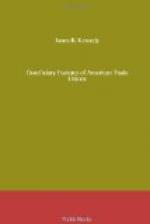The rate of the weekly sick benefit is five dollars in all the unions except the Tobacco Workers and the Pattern Makers. In the former it is three dollars and in the latter four. The Cigar Makers when they introduced the benefit paid three dollars per week for the first eight weeks and one dollar and a half for the second eight weeks.[149] After a year’s experience the amounts were increased to four dollars and two dollars, respectively; in 1884 to five dollars and three dollars; in 1891 the benefit was set at five dollars per week and the maximum period during which the benefit could be obtained was fixed at thirteen weeks.[150] The Typographia, introducing the benefit in 1884, fixed the amount at five dollars and paid the same rate without regard to the number of weeks the benefit had been paid. In 1888 the amount was increased to six dollars.[151] But in July, 1894, because of the drain on the funds of the union due to the depression of business, the amount was reduced to five dollars.[152] The Granite Cutters paid for a time six dollars, but since 1888 have simply allowed total or half exemption of dues.[153] The only other one of the unions which has reduced the amount of the benefit is the Pattern Makers. When this union introduced the sick benefit the amount paid was fixed at six dollars and twenty-five cents, but since 1900 only four dollars have been paid. The only union at present differentiating the amount of the benefit according to the length of the term of sickness is the Typographia.
[Footnote 149: Constitution, 1880, Art. 12.]
[Footnote 150: Constitution, 1881 (New York, 1881), Art. 9; 1884 (New York, 1884), Art. 9; 1891 (Buffalo, 1892), p. 28.]
[Footnote 151: 25 jaehrige Geschichte der Deutsch-Amerikanischen Typographia, p. 35.]
[Footnote 152: American Federationist, Vol. 2, No. 4, p. 62.]
[Footnote 153: Constitution, 1877 (Rockland, 1877), p. 31.]
The total amount which may be drawn in any one year in about one half the unions is sixty-five dollars; that is, thirteen weeks at five dollars per week. The largest amounts during any one year are paid by the Typographia, the Bakers and the Barbers. The Bakers and the Barbers allow members to draw $130 and $100, respectively, while a member of the Typographia may receive as much as $265 per year.
The table on page 82 shows the total and per capita cost of the sick benefit in four of the principal unions maintaining it.
The per capita cost in the four unions, for the last year in which data are available, ranged from $3.59 in the Cigar Makers to $2.18 in the Leather Workers on Horse Goods. The chief reason for the higher per capita cost to the Cigar Makers and the Typographia is the more liberal provision for the payment of the benefit. In both of these unions the relief is paid from the time the illness is reported. The Iron Molders and the Leather Workers do not pay a sick benefit unless the illness extends over two weeks.




